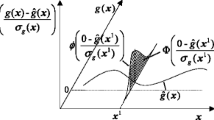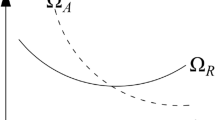Abstract
Reliability measures the ability that the structure finishes its intended function without failures by taking uncertainties into account. Reliability sensitivity commonly is defined as the partial derivative of the failure probability with respect to the distribution parameter, which is often of great importance for the reliability-based design optimization. In this paper, two improvements and one extension of the subdomain sampling (SS) method are researched. The first improvement is the criterion for adaptively determining the number of subdomains. The second improvement is that based on the first improvement, adaptive Kriging (AK) model is embedded into the modified SS (MSS) method to substitute the actual limit state function to identify the limit states of the samples generated in the MSS method. Through adaptively partitioning the distribution region, the size of candidate sampling pool in each circle of updating process of Kriging model is decreased compared with that in the method with the candidate samples being directly sampled in the whole uncertain distribution region, which improves the efficiency of each circle’s updating process. Then, the MSS-based adaptive Kriging (AK-MSS) method is extended to the reliability sensitivity analysis where no extra model evaluations are needed after the failure probability is assessed by the AK-MSS method. That is to say, the reliability and the reliability sensitivity can be simultaneously estimated by the AK-MSS method. Results of case studies in this paper demonstrate the effectiveness of the AK-MSS method.








Similar content being viewed by others
References
Aoues Y, Chateauneuf A (2010) Benchmark study of numerical methods for reliability-based design optimization. Struct Multidiscip Optim 41:277–294
Au SK, Beck JL (1999) A new adaptive importance sampling scheme for reliability calculations. Struct Saf 21(2):135–158
Au SK, Beck JL (2001) Estimation of small failure probabilities in high dimensions by subset simulation. Probabilistic Eng Mech 16(4):263–277
Au SK, Beck JL (2002) Importance sampling in high dimensions. Struct Saf 25:139–163
Beer M, Ferson S, Kreinovich V (2013) Imprecise probabilities in engineering analyses. Mech Syst Signal Process 37:4–29
Bichon BJ, Eldred MS, Swiler LP, Mahadevan S, McFarland JM (2008) Efficient global reliability analysis for nonlinear implicit performance function. AIAA J 46:2459–2568
Cadini F, Santos F, Zio E (2014) An improved adaptive kriging-based importance technique for sampling multiple failure regions of low probability. Reliab Eng Syst Saf 131:109–117
Depina I, Le TMH, Fenton G, Eiksund G (2016) Reliability analysis with metamodel line sampling. Struct Saf 60:1–15
Der Kiureghian A, Liu PL (1986) Structural reliability under incomplete probability information. J Eng Mech 112(1):85–104
Ditlevsen O, Madsen HO (1996) Structural reliability methods. Wiley, Chichester
Dubourg V, Sudret B (2014) Meta-model-based importance sampling for reliability sensitivity analysis. Struct Saf 49:27–36
Dubourg V, Sudret B, Bourinet JM (2011) Reliability-based design optimization using kriging surrogates and subset simulation. Struct Multidiscip Optim 44:673–690
Dubourg V, Sudret B, Deheeger F (2013) Metamodel-based importance sampling for structural reliability analysis. Probabilistic Eng Mech 33:47–57
Echard B, Gayton N, Lemaire M (2011) AK-MCS: an active learning reliability method combining Kriging and Monte Carlo simulation. Struct Saf 33:145–154
Echard B, Gayton N, Lemaire M, Relun N (2013) A combined importance sampling and Kriging reliability method for small failure probabilities with time-demanding numerical models. Reliab Eng Syst Saf 111:232–240
Fauriat W, Gayton N (2014) AK-SYS:an adaptation of the AK-MCS method for system reliability. Reliab Eng Syst Saf 123:137–144
Feng KX, Lu ZZ, Yun WY (2019) Aircraft icing severity analysis considering three uncertainty types. AIAA J 57(4):1514–1522. https://doi.org/10.2514/1.J057529
Gong W, Wang L, Khoshnevisan S, Juang CH, Huang H, Zhang J (2015) Robust geotechnical design of earth slopes using fuzzy sets. J Geotech Geoenviron 141(1):04014084
Hasofer AM, Lind NC (1974) An exact and invariant first order reliability format. J Eng Mech ASCE 100(1):111–121
Hastings WK (1970) Monte Carlo sampling methods using Markov chains and their applications. Biometrika 57:97–109
Hu Z, Mahadevan S (2016) A single-loop Kriging surrogate modelling for time-dependent reliability analysis. ASME J Mech Design 138(6):061406
Jiang C, Bi RG, Lu GY, Han X (2013) Structural reliability analysis using non-probabilistic convex model. Comput Methods Appl Mech Eng 254:83–98
Johnson AA, Jones GL, Neath RC (2013) Component-wise Markov chain Monte Carlo:uniform and geometric ergodicity under mixing and composition. Stat Sci 28(3):360–375
Juang CH, Gong WP, Martin JR (2017) Subdomain sampling methods - efficient algorithm for estimating failure probability. Struct Saf 66:62–73
Lee I, Choi KK, Gorsich D (2010) System reliability-based design optimization using the MPP-based dimension reduction method. Struct Multidiscip Optim 41:823–839
Li HS, Ma YZ, Cao ZJ (2015) A generalized subset simulation approach for estimating small failure probabilities of multiple stochastic responses. Comput Struct 153:239–251
Li G, He WX, Zeng Y (2019) An improved maximum entropy method via fractional moments with Laplace transform for reliability analysis. Struct Multidiscip Optim 59:1301–1320
Lu ZZ, Song SF, Yue ZF, Wang J (2008) Reliability sensitivity method by line sampling. Struct Saf 30:517–532
Metropolis N, Rosenbluth AW, Rosenbluth MN, Teller AH (1953) Equation of state calculations by fast computing machines. J Chem Phys 26(6):1087–1092
Papaioannou I, Betz W, Zwirglmaier K, Straub D (2015) MCMC algorithms for subset simulation. Probabilistic Eng Mech 41:89–103
Papaioannou I, Breitung K, Straub D (2018) Reliability sensitivity estimation with sequential importance sampling. Struct Saf 75:24–34
Pradlwarter HJ, Schueller GI, Koustourelakis PS, Charmpis DC (2007) Application of line sampling simulation method to reliability benchmark problems. Struct Saf 29(3):208–221
Rackwitz R (2001) Reliability analysis-a review and some perspective. Struct Saf 23(4):365–395
Sacks J, Schiller SB, Welch WJ (1989) Design for computer experiment. Technometrics 31(1):41–47
Song SF, Lu ZZ, Qiao HW (2009) Subset simulation for structural reliability sensitivity analysis. Reliab Eng Syst Saf 94:658–665
Tichy M (1994) First-order third-moment reliability method. Struct Saf 16(3):189–200
Tong C, Sun Z, Zhao Q, Wang Q, Wang S (2015) A hybrid algorithm for reliability analysis combining kriging and subset simulation importance sampling. J Mech Sci Technol 29(8):3183–3193
Waarts PH (2000) Structural reliability using finite element methods: an appraisal of DARS: directional adaptive response surface sampling. Ph.D. thesis. Technical University of Delft, The Netherlands
Wang ZQ, Chen W (2016) Time-variant reliability assessment through equivalent stochastic process transformation. Reliab Eng Syst Saf 152:166–175
Wang ZQ, Wang PF (2015) A double-loop adaptive sampling approach for sensitivity-free dynamic reliability analysis. Reliab Eng Syst Saf 142:346–356
Wang C, Qiu ZP, Xu MH, Qiu HC (2017a) Novel fuzzy reliability analysis for heat transfer system based on interval ranking method. Int J Therm Sci 116:234–241
Wang L, Liu DL, Yang YW, Wang XJ, Qiu ZP (2017b) A novel method of non-probabilistic reliability-based topology optimization corresponding to continuum structures with unknown but bounded uncertainties. Comput Methods Appl Mech Eng 326:573–595
Wei PF, Song JW, Bi SF, Broggi M, Beer M, Lu ZZ, Yue ZF (2019) Non-intrusive stochastic analysis with parameterized imprecise probability models: II. Reliability and rare events analysis. Mech Syst Signal Process 126(1):227–247
Xiao SN, Lu ZZ, Wang P (2018) Multivariate global sensitivity analysis for dynamic models based on wavelet analysis. Reliab Eng Syst Saf 170:20–30
Yun WY, Lu ZZ, Jiang X (2018a) A modified importance sampling method for structural reliability and its global reliability sensitivity analysis. Struct Multidiscip Optim 57:1625–1641
Yun WY, Lu ZZ, Zhang Y, Jiang X (2018b) An efficient global reliability sensitivity analysis algorithm based on classification of model output and subset simulation. Struct Saf 74:49–57
Yun WY, Lu ZZ, Jiang X (2018c) An efficient reliability analysis method combining adaptive Kriging and modified importance sampling for small failure probability. Struct Multidiscip Optim 58:1383–1393
Yun WY, Lu ZZ, Zhou YC, Jiang X (2019a) AK-SYSi:an improved adaptive Kriging model for system reliability analysis with multiple failure modes by a refined U learning function. Struct Multidiscip Optim 59:263–278
Yun WY, Lu ZZ, Feng KX, Jiang X (2019b) A novel step-wise AK-MCS method for efficient estimation of fuzzy failure probability under probability inputs and fuzzy state assumption. Eng Struct 183:340–350
Yun WY, Lu ZZ, Feng KX, Jiang X, Wang P, Li LY (2019c) Two efficient AK-based global reliability sensitivity methods by elaborative combination of Bayes’ theorem and the law of total expectation in the successive intervals without overlapping. IEEE Trans Reliab. https://doi.org/10.1109/TR.2019.2895866
Yun WY, Lu ZZ, Jiang X (2019d) An efficient method for moment-independent global sensitivity analysis by dimensional reduction technique and principle of maximum entropy. Reliab Eng Syst Saf 187:174–182
Zhang TX (2017) An improved high-moment method for reliability analysis. Struct Multidiscip Optim 56:1225–1232
Zhang XF, Pandey MD (2013) Structural reliability analysis based on the concepts of entropy, fractional moment and dimensional reduction method. Struct Saf 43(9):28–40
Zhao YG, Ono T (1999) A general procedure for first/second-order reliability method (FORM/SORM). Struct Saf 21(2):95–112
Zhao YG, Ono T (2001) Moment method for structural reliability. Struct Saf 23(1):47–75
Zhou YC, Lu ZZ, Cheng K, Yun WY (2019) A Bayesian Monte Carlo-based method for efficient computation of global sensitivity indices. Mech Syst Signal Process 117(15):498–516
Funding
This work was supported by the National Postdoctoral Program for Innovative Talents (Grant No. BX20190244), the Project funded by China Postdoctoral Science Foundation (No. 2019M661610) and the Natural Science Foundation of China (Grant No. 51775439).
Author information
Authors and Affiliations
Corresponding authors
Ethics declarations
Conflict of interest
The authors declare that they have no conflict of interest.
Additional information
Responsible Editor: Byeng D Youn
Publisher's note
Springer Nature remains neutral with regard to jurisdictional claims in published maps and institutional affiliations.
Appendix. Kriging model
Appendix. Kriging model
The Kriging model includes two parts. The first part is the parametric linear regression part, and the second part is the non-parametric stochastic process part. The Kriging model of an unknown function is described as follows (Sacks et al. 1989),
where \( B(u)={\left[{B}_1(u),{B}_2(u),\dots, {B}_p(u)\right]}^T \) are the base functions of vector , is the regression coefficient vector, and is the number of base function. is a stationary Gaussian process with zero mean and covariance which can is defined as follows:
where \( {N}_0 \) denotes the number of training points.
Define \( \boldsymbol{R}=\left[\begin{array}{ccc}R\left({\boldsymbol{u}}_1,{\boldsymbol{u}}_1\right)& \cdots & R\left({\boldsymbol{u}}_1,{\boldsymbol{u}}_{N_0}\right)\\ {}\vdots & \ddots & \vdots \\ {}R\left({\boldsymbol{u}}_{N_0},{\boldsymbol{u}}_1\right)& \cdots & R\left({\boldsymbol{u}}_{N_0},{\boldsymbol{u}}_{N_0}\right)\end{array}\right] \), B is a vector of B (u) and T is the corresponding vector of the function T (u) calculated at each experiment points uii = 1, 2, …, N0; the unknown β and σ2 can be estimated by the following equations, i.e.,
Therefore, the Kriging model and its variance are given as follows:
where \( {\boldsymbol{r}}^{\mathrm{T}}\left(\boldsymbol{u}\right)={\left[\boldsymbol{R}\left(\boldsymbol{u},{\boldsymbol{u}}_1\right),\dots, \boldsymbol{R}\left(\boldsymbol{u},{\boldsymbol{u}}_{N_0}\right)\right]}^{\mathrm{T}}. \)
Replication of results
The original codes of the examples in the Sect. 5 are available in the Supplementary materials.
Rights and permissions
About this article
Cite this article
Yun, W., Lu, Z., He, P. et al. Adaptive subdomain sampling and its adaptive Kriging–based method for reliability and reliability sensitivity analyses. Struct Multidisc Optim 61, 1107–1121 (2020). https://doi.org/10.1007/s00158-019-02412-6
Received:
Revised:
Accepted:
Published:
Issue Date:
DOI: https://doi.org/10.1007/s00158-019-02412-6




